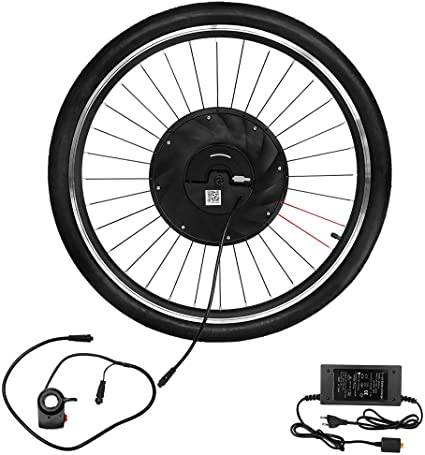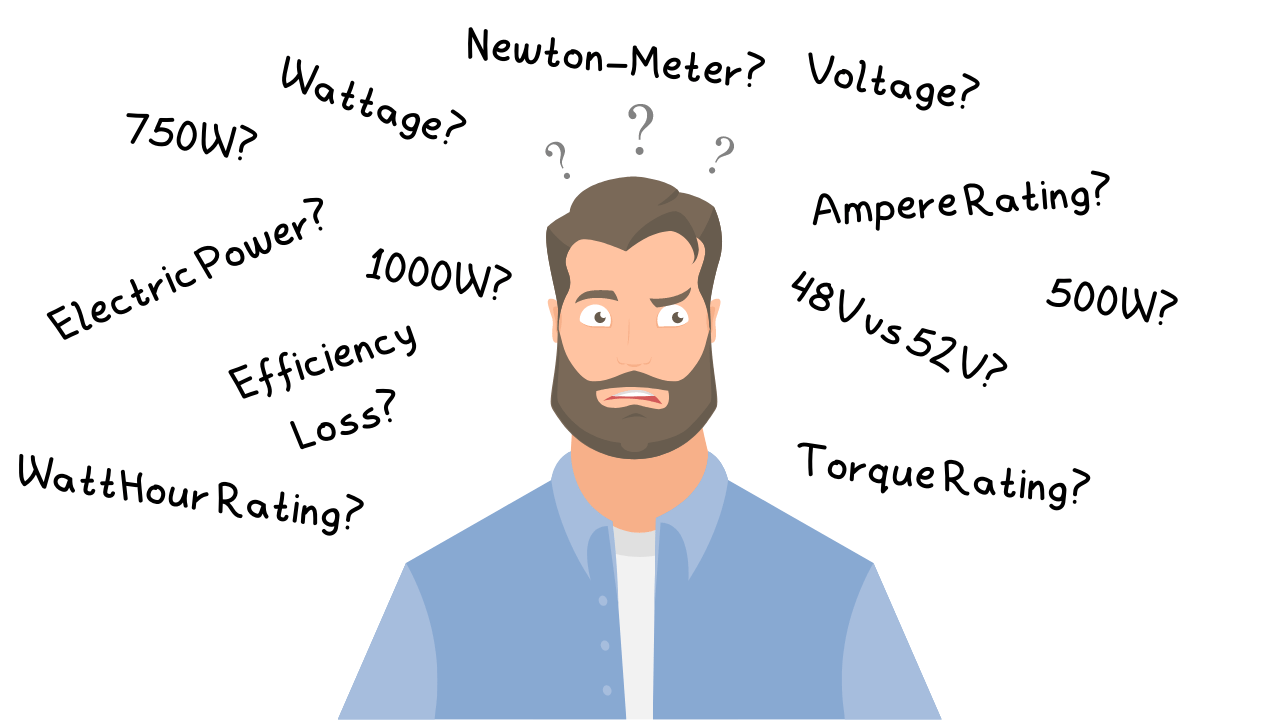Are you planning to buy an e-bike conversion kit to upgrade your existing one? With so many options, things could get confusing. Check out out this in-depth buying guide before you make up your mind!

Slowly but surely, people in the US are getting into e-bikes — the sales figures of e-bikes have increased eightfold since 2014. We feel that e-bikes can become an alternative to carbon-dumping fuel-powered vehicles.
It’s evident — e-bikes are here and they’re here to stay!
Now before you make up your mind and dispose of your old bike for an e-bike, hear me out. There is a simple way to “upgrade” your old bike to an e-bike.
All you need is an e-bike conversion kit!
This way, you can save a lot and avoid dumping your old bike into a landfill.
Now, here’s the issue — the e-bike conversion kit market is full of new companies and unknown brands. And, almost all of them are good. Rather than suggesting a few good names, I’ve decided to make a comprehensive buying guide so that YOU can choose the best option for yourself.
So, let’s get started with the e-bike conversion kit buying guide, shall we?
Why Should You Convert Your Bike to an E-bike?
In one phrase — elevating your overall biking experience.
A regular bike comes with a plethora of benefits. Not only you can dramatically improve your fitness, but you’re also helping nature by reducing your carbon footprint.
Now, an electric bike does all that but in a better way.
Think about it, you’re finally able to ditch your car for your daily commutes. So, you’ll be taking your e-bike out every day — there is no doubt that your fitness will improve. After all, you’ll have to pedal while riding your e-bike.
Also, you’ll NOT be sweating like hell on your commute to the office every morning as you’ll have an electric motor to assist your pedaling efforts.
Let’s talk about that electric motor part.
With the inclusion of the electric motor, we’re making the overall process green.
There will be fewer cars and motorbikes on road — which will drastically reduce the carbon emission rate in the air.
Can you imagine the positive impact on nature?
I am so glad that we’re finally looking at a green affordable alternative to our “carbon machines” — having an electric bike is one of the best things you can do to preserve our environment. Who doesn't know that e-bikes are solving city pollution and congestion?
So, should you buy an electric bike?
Sure, but you can save a lot by converting your old bike to an e-bike.
For example, a high-quality e-bike would cost you over $2,000. Compared to that, a top-shelf e-bike conversion kit comes at $400 to $500.
Sure, there are pricier options out there. Still, an ebike conversion kit would cost way less.
What Are the Types of E-Bike Conversion Kits?
Different brands opt for different solutions. However, you can divide them into three major categories —
Mid-Drive Conversion Kit
As the name suggests, mid-drive conversion kits come with a motor that sits between the pedals — in the middle of your bike.
Being a newer variant, mid-drives tend to be smaller and lightweight. Yet it can offer greater torque compared to other options. Also, as the motor sits in the middle, the weight balance is optimum — offering you the best riding experience.
As you can imagine, changing the tire becomes hassle-free.
I’d suggest going for a mid-drive conversion kit if you’re into off-roading or plan to use it in a mountain bike.
However, there is a major shortfall of this type of conversion kits.
They’re EXPENSIVE!
So, expect to pay premium prices to get your hands on a mid-drive conversion kit.
Currently, BAFANG BBSHD 46V 1000W mid-drive e-bike conversion kit is one of the popular options out there. You could check it out.
Mid-drives are more efficient, and are usually able to deliver more torque without expanding nearly as much battery capacity. So if you’re climbing hills, definitely if you’re off road, you want to have to get a mid-drive for that efficiency uphill and the torque.
Steven Sheffield, Product Manager at Bosch
Hub-Drive or Wheel Conversion Kit
Hub-drives are a traditional option. In fact, the first-ever design of an ebike, designed in 1895, had an electric motor connected to the rear wheel — the basic design principle of a hub-drive conversion kit.
You can further classify a hub-drive design into two categories — front wheel and rear wheel. The first option comes with a motor attached to the front wheel, while the second option has it in the rear one.
The two biggest advantages of a hub-drive — affordability and versatility.
Sure, the weight becomes slightly off-balanced as the motors are bulkier. But they’re cheap and easier to install.
If you’re only planning to use your converted e bike for daily commutes, a hub-drive is more than capable enough.
For example, this Lixada Hub-Drive motor is one of the best in the market.
Friction Drive Conversion Kit
Lastly comes the friction drive conversion units.
Frankly, from a personal point of view, I’m not a big fan of this conversion unit.
There, I said it!
The basic principle works like this — the kit comes with a roller attached to the motor. When the motor activates, it powers the roller that moves the rear wheel using friction.
For me, the biggest drawback is the noise.
Also, the traction between the roller and wheel decreases drastically during rain. Overall, the mechanism is neither efficient nor balanced.
Header | Mid-Drive | Hub-Drive | Friction Drive |
|---|---|---|---|
Motor Position | Crank | Front or Rear Wheel | Rear Wheel |
Weight Balance | Balanced | Off-Balanced | Off-Balanced |
Torque Generation | Highest | Average | Lowest |
Roller Dependent? | No | No | Yes |
Ease-of-Installation | Complex | Depends on the Mechanism | Simple |
Price | Expensive | Cheap | Cheapest |
Things To Consider Before Buying an E-bike Conversion Kit
Which Type of Motor Does the E Bike Kit Use?
While we emphasis so much on the type of conversion kits, we rarely focus on the type of motor the kit uses. There are two varieties available — brushed and brushless.
Of course, brushless motors are the desirable option here. They run silent, offer higher power output, and are less prone to wear and tear.
Isn’t there any drawback for brushless motors?
Yes!
Brushless motors are quite expensive compared to their brushed counterparts. If you’re looking for something cheaper, you might have to settle for a brushed motor.
If possible, try to go for brushless motors as the overall experience will be far superior.
Wait, there’s more!
If you’re into hub-drive electric bike kits, you should inquire if the motor is a direct-drive or a geared one.
Direct-drive motors are heavier and more powerful — offering higher top speed. Geared motors are lighter and can generate more torque. Both of them come with pros and cons.
Please research before you make up your mind.
How Much Power Does Electric Bike Kit Pack?
Things get confusing very easily while comparing power metrics like watts, volts, amps, watt-hours, etc.!
Let me simplify things for you.
If you’re only looking for more power from your e-bike kit, look for the wattage rating.
Simply put, a 750W motor will pack more punch than a 500W motor.
Well, duh!
However, manufacturers might not inform you of the time duration for the rated power output. So, your 750W motor might NOT always offer 750W output but only for a brief time.
That could be 10 seconds or 30 seconds. Some motors quote peak power at 750 watts, but you may only be able to get that for 1 to 2 seconds.
Jonathan Weinert, Sales and Marketing Manager for Bosch e-Bike Systems
Then, some of you might try to calculate the wattage based on the battery voltage and the motor’s current rating. We all know the formula —
Electric Power (W) = Voltage (V) × Current (Amp.)
So, for example, a 48V battery and 20A motor should offer you 960W (48V × 20A) power, right?
Again, wrong!
You’re forgetting about the electrical efficiency. A typical motor is about 75% efficient. So, you’d be getting about 720W power (theoretical maximum) from your e-bike kit.
Another good metrics is the Watt-Hour rating.
It tells you how much wattage you can expect your battery to deliver in an hour. You should also consider efficiency loss using this metric.
That’s a pickle!
What should you do?
I’d suggest you put emphasis on the torque rating (Nm). It’ll help you to understand how much power your motor is offering in real-time.
Simple and easy!
Sensors Play a Major Role
One of the key features of an electric bike is that your pedaling style determines the motor’s behavior. E bikes or e bike kits come with two types of sensors — cadence sensor and torque sensor.
Cadence sensors measure how fast you’re pedaling. The faster your pedal, the more power you get from the motor, the faster you go.
Cadence sensors are commonly used in hub-drives.
Torque sensors, on the other hand, measure how hard you’re pedaling. The harder you push the pedal, the more power you get from the motor, the faster you go. These are typically seen in mid-drives.
Does Your Electric Bicycle Kit Come with A Throttle?
Pedaling is not the only way to ride your e bike — some bikes come with throttle too. You can get instant power from your motor with a push of a button.
While the feature is quite handy and fun to use, there remains the question of legality.
Why?
Because cyclists can exceed the speed limit which may lead to road accidents.
Wait, Are You Breaking Any Local Law?
As I’ve mentioned in the previous section, e-bike speed is subjected to legality. For example, throttle-controlled e-bikes were illegal in New York City until 2020. It’s a relief that it’s legal now. Also, we're seeing the addition of cylcing lanes in New York City Brooklyn and Queensboro bridges.
However, most of the States have restricted the speed limit to 20mph.
Also, you should know that e-bikes are classified into three categories and the States strictly ban some classes of ebikes.
They are —
- Class-I: E-bikes with only pedal assist and max speed of 20mph.
- Class-II: E-bikes with pedal and throttle assist and max speed of 20mph.
- Class-III: E-bikes with pedal assist (with or without throttle assist) and max speed of 28mph.
Does It Come with A Battery?
It’s a somewhat important buying consideration. Many brands don’t include a battery in the e-bike conversion kits as a sales tactic.
Of course, you can ask lower price if your kit doesn’t include a battery. These deals can even pose as a better option to many buyers.
Little that they know, an ebike battery is quite expensive. Think of this Unit Pack Power Official 20Ah /15Ah / 13Ah Ebike Battery. It’s an exceptionally great battery but it costs about $270!
So, try to go for an e-bike conversion kit that comes with a battery.
Should You Go for Any Unknown Brand?
YES, DEFINITELY!
It can’t stretch this enough. I know it’s quite unusual to go for unknown brands for any electrical or electronic product.
But the thing is — the e-bike market is extremely new and hundreds of brands are just getting started with this product.
Till the market matures it’s way too soon to label any brand as the market leader. It’s good for the market itself as different companies are innovating new features every other day.
So, feel free to go for a new, unknown brand — it might even become a market leader someday.
How to Install an E-bike Conversion Kit?
You can place the main motor either on the wheels (hub-drive) or on the crank (mid-drive). So, the installation process can be divided into two directions.
However, today, we'll only check out the installation process for a hub-drive motor.
NOTE: The installation process varies from model to model. Here, I’m discussing the installation process of EBIKELING 1500W Direct Drive Electric Bike Conversion Kit.
Step 1: Remove the Existing Wheel
Most modern hub-drives come with a motorized wheel. So, you’ll not have to go through the hassle of mounting the motor yourself.
First, you’ll have to swap the existing wheel with the motorized wheel that came with the conversion kit. With the bike tool kit, you’ll have to loosen the rear brake and wheel quick release level.
Once they loosen up, you should be able to remove the existing wheel.
Step 2: Attach the Tire, Tube, and Freewheel to New Wheel
Now, you’ll have to attach the existing tire and tube from the old wheel to the new one. Again, the bike tool kit should come in handy — it should contain some tire levers.
You may or may not re-use your old freewheel. Some e-bike kits come with a new freewheel.
In that case, you should use the new one.
Make sure to use enough spacers so that things don’t clash against each other.
Step 3: Mount the Motorized Wheel to the Bike
Once you’ve attached the freewheel and the washers properly, you’re ready to mount the wheel to your bike. Make sure to securely tight the nuts and install the torque-arm set in the correct way. Follow the instructions in the manual.
**You should use the provided nuts with the kit
Step 4: Run the Wire and Do Necessary Cable Management
This step is fairly straightforward — run the motor cable to the battery to the handlebars.
While you run the cables, you should secure them with zip-ties. This will help to organize things properly and might save you from a nasty accident!
Step 5: Install the Display and Controls
First, remove existing grips, gear shifters, and brakes from the handlebars. Then, mount the display unit any place you prefer.
Next, install —
- Throttle — thumb throttle/half-twist throttle
- Brakes and brake wires
- Pedal-assist sensor
- Speed shifter
- Cruise control
**Based on the model of your e-bike conversion kit, the number, and type of control units may vary.
Step 6: Install the Battery
The last and final step is to install the battery. Sadly, EBIKELING 1500W Direct Drive Electric Bike Conversion Kit doesn’t include a battery with the kit. So, you’ll have to get an after-market battery that matches the motor specification.
If your bike kit comes with a battery, you should install that one.
Voila, you’re ready to ride!
Final Thoughts
Yes, installing an e-bike conversion kit might be a bit too complicated for most of us. But once you successfully install the kit, it’s one of the fulfilling experiences.
Now, if you prefer and simpler and more convenient option, it’s better to go for a new e-bike for yourself.
Either option seems great to me.
I hope the guide answers all your questions regarding e-bike conversion kits. If you have further questions, let me know in the comments below.















I live in a small to medium size city; am I going to have a hard time finding a bike shop to service a conversion ebike?
I’ve had an Ecotric.. LOVED IT. Had a Lectric XP 1.0….LOVED IT.
Well, now I’m determined to build what I want…legality be damned…lol. I like the 1500w conversion kit you mentioned but how much trouble would it be to install 2. One on the front, and one on the back? Also, how much true speed would I get out of it? Can I run both off of one controller and would I need a 72v battery to compensate for having 2 motors?
You see where I’m going with this….simplified Godzilla on 3 wheels. Hook me up with the answers I seek, Good sir!!
Not that easy, the easy way for AWD would be whatever you want in the back or middrive you can get a blue tooth controlled 350 watt all in one for the front 36 volt, all you do is bolt on and the choice of rear wheel drive would be up to you you can put some kind of a monster middrive or big hub motor in the back which can easily exceed 3o mph, the front “IMortor” is more modest speed wise with battery capacity limited to 7.2 ah, heavy but it works it would get you home if the mid drive destroyed the rear drive system( if you want a cheaper E motorcycle get a Surron) Yes there are controllers that will control 2 motors the thing to remember is it could get very expensive and frustrating, check out the “Juiced 52 volts if you want turnkey 30+ mph speed.
Looking for a mid drive system for my Norco Bigfoot hardtail mountain bike that will give various increasing levels of pedal assist or leave in manual mode plus throttle only motor drive – when required .
Get one with a torque sensor.
I’ve converted my bikes before, and I’m looking for a conversion kit that doesn’t have the needless Pedal-Assist-System. Do you know where I can find this?
-Su
What a great question Su! Yes, there are non-pedal assist systems. For example, e-RUN Wheel ERW-330 (http://erunspace.com/en/bbs/content.php?co_id=s0101&ckattempt=1) is a great e-bike conversion kit for this case. You can turn off the motor to stop the pedal assist. If you’re looking for an e-bike, you can check out Rad Power Bikes (https://www.radpowerbikes.com/).
Please let me know if you have further questions.